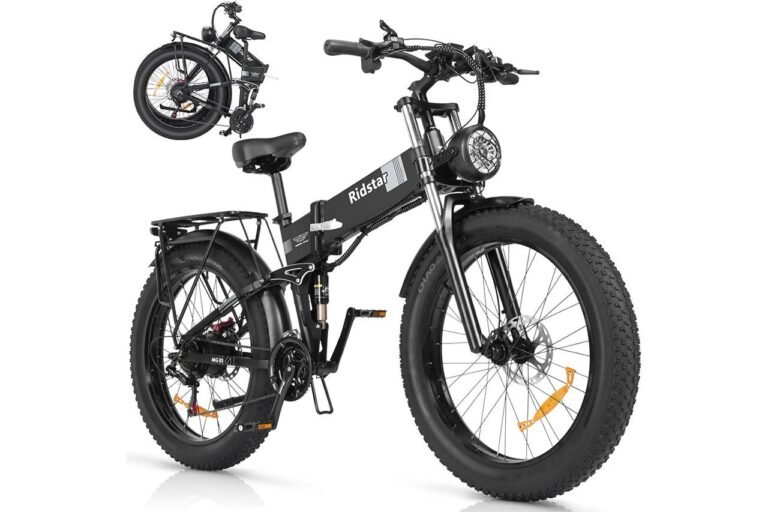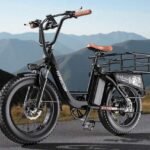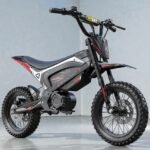
Electric bikes have surged in popularity, blending convenience, eco-friendliness, and fun into one package. In this article, we’re pitting two impressive models from Philodo—the H8 and the H7—against each other to help you decide which one suits you best. As someone who’s ridden both, I’ll break down their strengths and weaknesses across key factors.
The Philodo H8 boasts dual 1000W motors and a beefy 23Ah battery, built for power-hungry riders who love off-road challenges. Meanwhile, the H7 keeps things simpler with a single 1000W motor and a 17.5Ah battery, offering solid performance at a friendlier price.
Stick with me as we dive into the nitty-gritty, comparing everything from power to price. You’ll know exactly which bike fits your life by the end.
Philodo H8 vs. Philodo H7 – How We’ll Compare Them
| Preview | Product | Price | |
|---|---|---|---|
|
|
PHILODO Electric Bike for Adults, Fat Tire Ebike 26″ Electric Bike 1000W Electric Mountain Bike… | View on Amazon |
I’ve put both bikes through their paces, and now I’ll compare them on what matters most to riders like you. Here’s what we’ll look at:
- Motor Power and Performance: How much oomph each bike delivers and how it feels on different terrains.
- Battery Life and Range: How far you can go before plugging in, a big deal for long rides.
- Speed and Acceleration: How fast they go and how quickly they get there—key for thrill-seekers.
- Climbing Ability: Their knack for tackling hills, crucial if your rides get steep.
- Comfort and Ergonomics: How they feel under you, especially on longer trips.
- Build Quality and Durability: Whether they can take a beating and keep rolling.
- Price and Value: What you get for your money, because budget matters.
These factors will guide us through a head-to-head showdown.
Motor Power and Performance
Philodo H8
The H8’s dual 1000W brushless motors—one front, one rear—pack a serious punch, totaling 2000W. Riding it feels like unleashing a beast; the torque grips loose dirt or sand like glue. It’s a dream for off-road trails, powering through obstacles effortlessly. The throttle kicks both motors into gear, making it a traction champ.
Score: 9/10
Philodo H7
The H7 rocks a single 1000W rear motor—still plenty strong for most rides. It’s smooth on pavement and handles light off-roading well, though it lacks the H8’s brute force. Paired with pedal assist, it’s a reliable workhorse for daily use.
Score: 7/10
How They Compare
The H8’s dual motors outmuscle the H7, shining on tough terrains where traction is king. The H7 holds its own for casual rides but can’t match that raw power. For adventure junkies, the H8 wins; for everyday ease, the H7’s enough.
Winner: Philodo H8
Battery Life and Range
Philodo H8
With a 48V 23Ah (1104Wh) battery, the H8 keeps you going—up to 50 miles on flat ground with light throttle use. Hills and heavy throttle cut that down, but it’s still a long-haul champ. The removable design makes charging a breeze.
Score: 8/10
Philodo H7
The H7’s 48V 17.5Ah battery is smaller, likely hitting 30-40 miles under similar conditions. It’s fine for shorter trips, but you’ll charge it more often. It’s removable too, which is handy.
Score: 6/10
How They Compare
The H8’s bigger battery means longer rides without worry—perfect for explorers. The H7 suits shorter jaunts but lags for distance. If range is your thing, the H8 takes it.
Winner: Philodo H8
Speed and Acceleration
Philodo H8
The H8 hits 35 mph, and its dual motors make acceleration snappy—great for zipping through traffic or trails. It feels responsive, picking up speed fast after stops. It’s a rush worth experiencing.
Score: 9/10
Philodo H7
Topping out at 31 mph, the H7’s single motor accelerates well but not as fiercely as the H8. It’s quick enough for most needs, just a touch less thrilling.
Score: 7/10
How They Compare
The H8 edges out the H7 in speed and snap, ideal for those who love a fast ride. The H7’s no slouch, but it’s tamer. Speed freaks pick the H8.
Winner: Philodo H8
Climbing Ability
Philodo H8
Those dual motors make the H8 a hill-crushing machine. Steep inclines barely slow it down, and the extra traction shines on loose ground. It’s built for the tough stuff.
Score: 9/10
Philodo H7
The H7 climbs decently with its rear motor, managing moderate hills fine. Steeper ones need more pedaling, though—it’s not as effortless as the H8.
Score: 7/10
How They Compare
The H8’s power and grip dominate hills, beating the H7’s solid but lesser effort. For hilly rides, the H8’s your pick.
Winner: Philodo H8
Comfort and Ergonomics
Philodo H8
The H8’s suspension fork with lockout soaks up bumps, and fat 26″ x 4.0″ tires smooth the ride. Its 18-inch frame fits taller folks best, with adjustable seat and bars for a custom feel.
Score: 8/10
Philodo H7
The H7 matches with a suspension fork and fat tires, comfy on rough patches. Its 17-inch frame suits average heights, and adjustments keep it cozy.
Score: 8/10
How They Compare
Both bikes ride smooth and comfy, differing only in frame size—H8 for taller, H7 for medium builds. It’s a dead heat here.
Winner: Tie
Build Quality and Durability
Philodo H8
The H8’s 6061 aluminum alloy frame feels rock-solid, paired with hydraulic brakes and Shimano gears. It’s taken trail abuse and stayed strong, looking sharp too.
Score: 8/10
Philodo H7
The H7’s aluminum frame and quality components mirror the H8’s toughness. It’s held up just as well under regular use.
Score: 8/10
How They Compare
Both are built to last, with no real difference in durability. They’re equally trusty companions.
Winner: Tie
Price and Value
Philodo H8
The H8 costs more, reflecting its dual motors and big battery. It’s a fair deal for power seekers, but overkill if you don’t need it.
Score: 7/10
Philodo H7
Cheaper than the H8, the H7 delivers strong bang for your buck. It’s a steal for practical riders.
Score: 9/10
How They Compare
The H7 wins on value, offering great performance for less. The H8’s premium price suits those who’ll use its extras.
Winner: Philodo H7
The Breakdown
Here’s the scorecard after testing both bikes head-to-head:
| Factor | Philodo H8 | Philodo H7 |
|---|---|---|
| Motor Power | 9/10 | 7/10 |
| Battery Life | 8/10 | 6/10 |
| Speed | 9/10 | 7/10 |
| Climbing Ability | 9/10 | 7/10 |
| Comfort | 8/10 | 8/10 |
| Build Quality | 8/10 | 8/10 |
| Price and Value | 7/10 | 9/10 |
| Total Score | 58 | 52 |
The Winner – Philodo H8
The Philodo H8 comes out on top with 58/70, edging out the H7’s 52. Its dual motors, longer range, speed, and hill prowess make it a powerhouse for demanding riders. I’ve pushed it through trails and steep climbs, and it never flinched—perfect for adventure lovers.
That said, the H7’s no loser. Its lower price, solid performance, and comfort make it a fantastic pick for commuting or casual rides. I’ve enjoyed its reliability on daily spins without feeling shortchanged.
Your call depends on what you need: the H8 for max power and range, or the H7 for smart value. Both are winners in their own right.


![CTVVXXC EB2 Pro Electric Bike Review ([year]): 6000W Power, 45 MPH Speed CTVVXXC EB2 Pro Electric Bike Review: 45 MPH Dual-Motor Fat-Tire Beast for All-Terrain Riders](https://goebikelife.com/wp-content/uploads/2025/11/CTVVXXC-EB2-Pro-Electric-Bike-Review-768x512.jpg)
![The Best Electric Bicycle for Adults in [year]: Top 10 Models, Reviews, and Buying Tips Best Electric Bicycle for Adults](https://goebikelife.com/wp-content/uploads/2025/04/Best-Electric-Bicycle-for-Adults-768x512.jpg)




